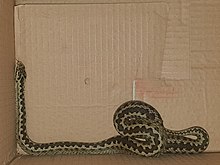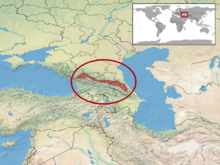| Vipera lotievi | |
|---|---|
 | |
| Scientific classification | |
| Domain: | Eukaryota |
| Kingdom: | Animalia |
| Phylum: | Chordata |
| Class: | Reptilia |
| Order: | Squamata |
| Suborder: | Serpentes |
| Family: | Viperidae |
| Genus: | Vipera |
| Species: | V. lotievi |
| Binomial name | |
| Vipera lotievi | |
 | |
| Synonyms | |
Vipera lotievi, commonly known as the Caucasian meadow viper [3] and Lotiev's viper, [4] is a species of venomous snake in the family Viperidae. The species is native to Azerbaijan, Georgia, and Russia. There are no subspecies that are recognized as being valid. [5]